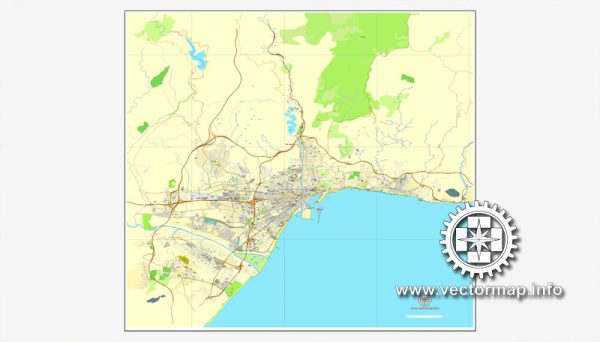Malaga, located on the southern coast of Spain, is a city rich in history and culture, with a blend of Moorish, Roman, and Renaissance influences.
Vectormap.Net provide you with the most accurate and up-to-date vector maps in Adobe Illustrator, PDF and other formats, designed for editing and printing. Please read the vector map descriptions carefully.
Here’s a detailed description of some of the historic places, buildings, streets, and squares in Malaga:
- Alcazaba: The Alcazaba is a fortress that dominates the skyline of Malaga. It was built in the 11th century by the Moors and later expanded by the Nasrid dynasty. The fortress is a fine example of Islamic military architecture, with beautiful gardens, courtyards, and stunning views of the city and the Mediterranean Sea.
- Gibralfaro Castle: Situated on the hill overlooking the Alcazaba, Gibralfaro Castle provides panoramic views of Malaga. The castle was built in the 14th century to protect the Alcazaba and the city from attacks. It’s a steep but rewarding climb to reach the castle, and visitors can explore its towers and walls.
- Malaga Cathedral (Catedral de la Encarnación): This Renaissance cathedral, also known as La Manquita (one-armed lady), combines Gothic, Renaissance, and Baroque architectural styles. Construction began in the 16th century but continued for centuries, resulting in a unique blend of architectural elements. The interior houses impressive artworks and chapels.
- Roman Theatre (Teatro Romano): Discovered in the 1950s, the Roman Theatre dates back to the 1st century BC and was used until the 3rd century AD. The theater, located at the foot of the Alcazaba, is one of the oldest in Spain. Visitors can explore the archaeological site, which includes the stage, seating areas, and adjacent structures.
- Plaza de la Merced: This lively square is a central gathering place in Malaga. It is surrounded by cafes, restaurants, and bars and features a monument dedicated to General Torrijos. The birthplace of Pablo Picasso is also located on one side of the square, and visitors can explore the Picasso Museum in the vicinity.
- Calle Larios: Known as the main shopping street of Malaga, Calle Larios is a pedestrianized avenue lined with shops, boutiques, and cafes. The street is beautifully adorned with ornate lampposts and is a popular spot for both locals and tourists to stroll and enjoy the vibrant atmosphere.
- Plaza de la Constitución: At the heart of the historic center, this square is surrounded by historic buildings and is a hub of social activity. The square is often used for events, celebrations, and performances. The architecture around the square reflects various historical periods.
- Museo Picasso Málaga: Located in the Buenavista Palace, this museum is dedicated to the life and works of the renowned artist Pablo Picasso, who was born in Malaga. The collection includes paintings, sculptures, ceramics, and drawings, providing insight into Picasso’s artistic evolution.
- Atarazanas Market: This historic market dates back to the 14th century and was originally a shipyard during Moorish rule. The present market building, with its impressive stained glass window, hosts a vibrant food market where visitors can sample fresh local produce.
Exploring these historic places, buildings, streets, and squares in Malaga provides a fascinating journey through the city’s rich and diverse history.


 Author: Kirill Shrayber, Ph.D.
Author: Kirill Shrayber, Ph.D.